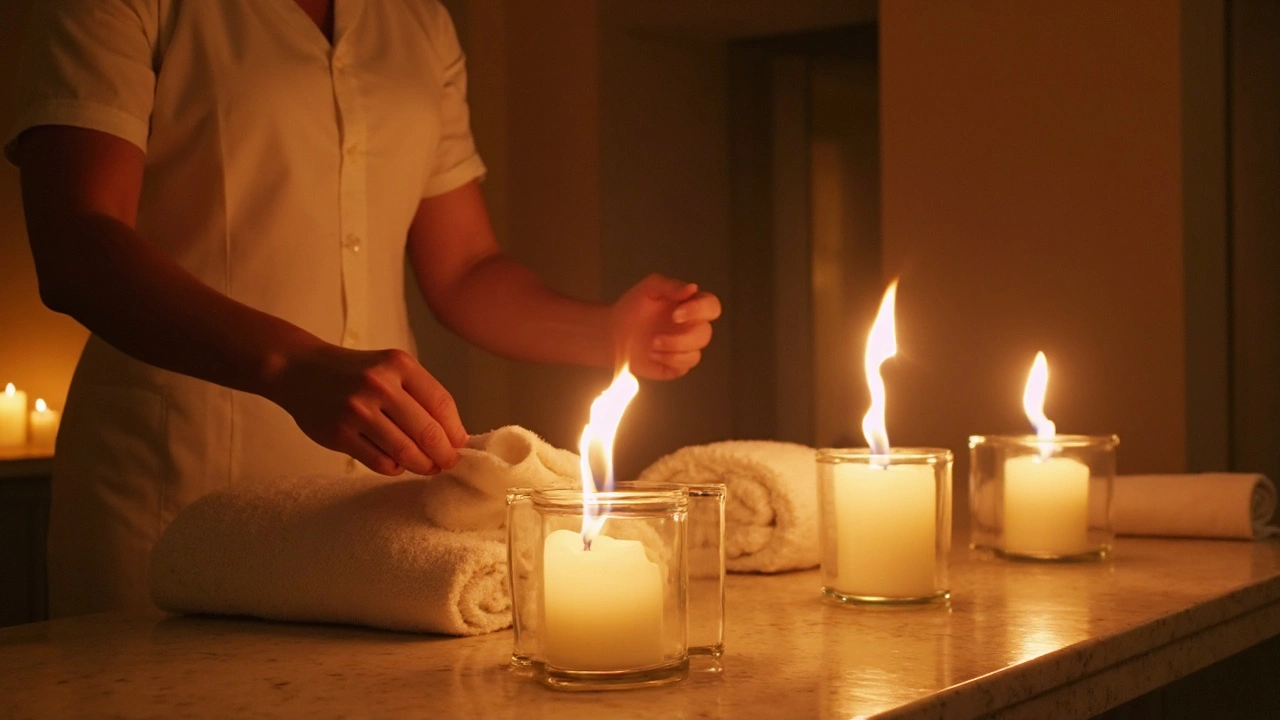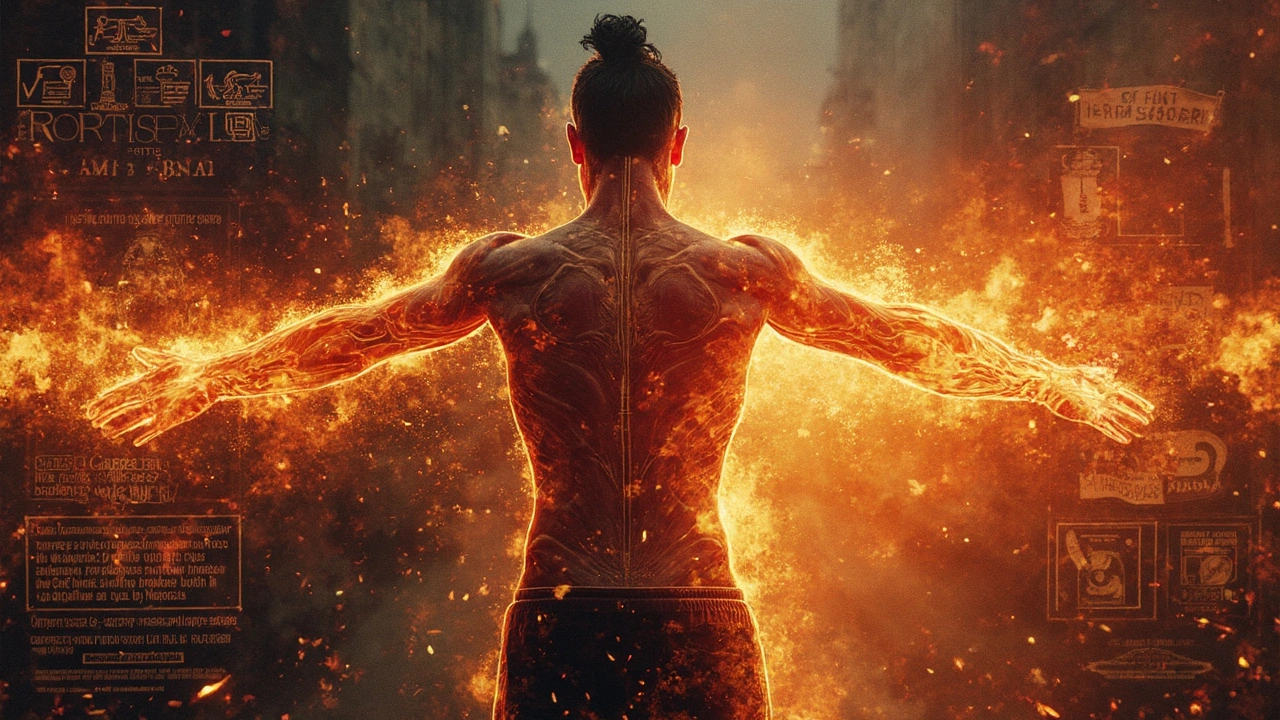Fire Massage: Everything You Need to Know Before Trying It

- May, 20 2025
- 0 Comments
- Ethan Rainford
Fire massage sounds wild, right? Imagine lying on a table, feeling the heat of controlled flames on your back. It’s not a magic show or daredevil stunt—it’s a real therapy practiced in parts of China, Russia, and a few luxury spas worldwide. Think of it as a mix between traditional heat therapy and a bit of adrenaline.
Why would anyone want fire that close? The heat from the flames is meant to relax tight muscles, boost your circulation, and supposedly help with aches and pains. Some folks claim it reduces stress almost instantly, maybe because your brain knows you’re doing something seriously out of the ordinary. The therapist doesn’t just light a fire and walk away. Instead, wet towels and a special “fire elixir” keep things safe (when done right, anyway), and the flames only touch the cloth, not your skin directly.
But here’s what you need to know first: fire massage isn’t for everyone, and it’s definitely not a DIY kind of thing. If the person doing it isn’t highly trained, you could get burned—literally. Not all spas are qualified, so knowing what to look for could save you a world of pain. Get familiar with how it’s supposed to work, what the risks are, and simple red flags to avoid before you ever book an appointment.
- What Is Fire Massage?
- How Does Fire Massage Work?
- Is Fire Massage Safe?
- Who Should Try or Avoid Fire Massage?
- Finding a Trained Professional
What Is Fire Massage?
Fire massage is a type of alternative therapy that involves applying controlled flames over specific areas of the body. This isn’t a gimmick you see at tourist markets—fire massage has roots in Traditional Chinese Medicine (TCM), where it’s sometimes called "huǒ liáo." The idea is to use heat in a targeted way to relax muscles and stimulate blood flow. It’s gained attention in places like Taiwan, parts of Eastern Europe, and, more recently, high-end spas in other countries.
During a fire massage session, a trained practitioner covers the treatment area (usually the back, legs, or feet) with a towel soaked in a special alcohol-based solution or herbal elixir. This towel is never applied directly to the skin—the therapist always keeps a protective barrier in place. Next, the practitioner lights the towel very briefly, allowing flames to heat the body area for a few seconds, then puts it out with another wet towel. The process can be repeated a few times as needed during one session.
People try fire massage for different reasons. Some are curious about the unique experience, while others hope it’ll help with muscle pain, stress, or cold limbs. In TCM circles, it’s believed that the heat “awakens” energy channels and drives out “cold” and “dampness” from the body, which are blamed for sluggishness and aches.
Fire massage shouldn’t be confused with fire cupping or regular hot stone massage. It’s a distinct technique with different tools and traditions. The number one rule here? Skilled hands only. This therapy is never supposed to burn skin, cause pain, or leave permanent marks. When done the right way, only warmth and a sense of relaxation should follow.
How Does Fire Massage Work?
If you picture fire massage as someone just waving a torch over you, that’s not even close. Most places use a method called "Huǒ liáo" in China, which means “fire therapy.” Let's break it down step by step so you know what you're getting into.
- First, the therapist soaks a thick towel or cloth in a special herbal solution. This solution often combines alcohol, aromatic oils, and herbs that supposedly help with muscle tension and pain.
- The soaked cloth is placed on your back (or sometimes other parts—usually safe, fleshy spots, never on bony or sensitive areas).
- Another, dry cotton towel goes on top to act as a shield between you and the actual flame.
- The therapist pours a little alcohol on the top towel, then lights it up for just a few seconds—usually 3–10 seconds per area. The flame burns hot and fast, but the layers keep your skin safe.
- After that quick flame burst, they snuff it out immediately using another damp cloth. The process might repeat on different muscle groups during one session.
The whole idea is that the quick, controlled heat penetrates deep into the muscles, ramping up blood flow and relaxing knots faster than a typical hot stone massage. Some therapists will add light pressure, massage strokes, or gentle tapping once the fire step is done.
Here’s a handy table showing what usually goes into a single fire massage session:
| Step | Main Thing Used | Purpose |
|---|---|---|
| Cloth Soak | Herbal solution | Prepares and protects skin |
| Towel Layer | Dry cotton towel | Acts as flame barrier |
| Ignition | Alcohol | Creates quick, controlled flame |
| Flame Application | Open flame | Delivers heat therapy |
| Extinguish Flame | Wet towel | Keeps things safe—no burns |
Sessions often last 15–20 minutes, but the flame time over each area is super short. Some folks feel an intense warmth right away, followed by classic muscle relaxation and looseness.
Don’t forget, a skilled hand makes all the difference. If the person doesn't get the timing or layers just right, burns can happen. That’s why real training and experience matter way more here than with other spa treatments.

Is Fire Massage Safe?
Here’s the honest deal—fire massage isn’t automatically dangerous, but safety depends almost entirely on the skill of your therapist. The therapist uses a towel soaked in alcohol or a special burning liquid, puts it on your back, and then lights it for a short burst. There’s a method for how long the flames stay lit—usually just a few seconds. Done right, you’ll only feel heat, not pain.
Still, there are real risks if safety steps aren’t followed. In rare cases, people have been burned or suffered from skin irritation. You’re putting fire on your body, so it’s no small deal. Not all spas or therapists follow strict protocols, especially in countries where rules aren’t enforced tightly. That’s why the number one rule before booking a fire massage: check the therapist’s experience and reputation.
- Ask about their training and certifications.
- Find reviews or testimonials online.
- Check if they use fresh towels and their own mixing protocol for the burning liquid.
- If your therapist can’t explain every step, walk away.
Some people have skin that’s too sensitive, or they have allergies to the burning agents, so be sure you mention any conditions or concerns up front. Also, kids, pregnant women, and folks with heart issues or skin disorders shouldn’t try this therapy at all.
| Risk Factor | Likelihood | Prevention |
|---|---|---|
| Minor burns | Low (under trained hands) | Short flame exposure, proper towels/liquid |
| Skin irritation | Moderate | Patch test, avoid sensitive skin |
| Allergic reaction | Low-Moderate | Ask about ingredients, disclose allergies |
| Severe burns | Very rare | Go only to verified professionals |
Bottom line: fire massage can be safe with a pro. But don’t just get wowed by the flames. Do your homework first. If you feel uncomfortable at any point, tell your therapist to stop right away. Don’t ever let anyone pressure you into a session if you have doubts.
Who Should Try or Avoid Fire Massage?
Fire massage isn’t a one-size-fits-all solution. This type of therapy gets a lot of hype, but you really need to know if it’s a good fit for your own health. Not everyone can handle the intense heat or the thrill of being under open flames, no matter how safe it’s supposed to be in trained hands. Here’s how to figure out if this is for you—or if you’re better off skipping it.
If you’re healthy, don’t have major skin conditions, and aren’t on medication that affects your skin or circulation, you might enjoy this intense version of heat therapy. Athletes who already use hot packs or sauna-type treatments sometimes try fire massage for muscle recovery or even just to beat stress. People who like new wellness experiences and can stay completely still during the treatment usually have the best results.
- If you have diabetes or any condition where nerves or blood flow are affected, fire massage is generally a bad idea. You might not feel burns or might heal slowly.
- Anyone with heart disease, high blood pressure, or a history of fainting should avoid fire-based therapies. The sudden heat can put extra strain on your body.
- Pregnant women should skip it. Rapid temperature changes could be risky for you and your baby.
- If you have skin conditions like eczema, psoriasis, or even just a tendency toward rashes, the heat and pressure could trigger a flare-up.
- Folks with allergies to massage oils, alcohol, or specific herbal mixtures used in the process should double-check the ingredients. Ask about everything being used up front.
- Kids and older adults should avoid it. Their skin is thinner and more likely to get burned.
There’s this myth that fire massage burns fat. It doesn’t. What you do get is a rush of heat that relaxes muscles, maybe kicks up your adrenaline, and can lower stress when professionals do it right. You won’t walk out noticeably slimmer, though.
Check out the basic health red and green lights for this therapy below:
| Who Can Try | Who Should Avoid |
|---|---|
| Healthy adults (no chronic illnesses) | Pregnant women |
| Athletes (as part of recovery, with doctor’s OK) | People with diabetes |
| Those who handle heat well and enjoy new wellness experiences | People with heart conditions or high blood pressure |
| Anyone with skin diseases or allergies to ingredients used | |
| Children and seniors |
The bottom line? Be honest about your health before you book a session. Even with the fire massage trend getting more attention, safety has to come first.

Finding a Trained Professional
Not every spa offering a fire massage is legit. In fact, a 2023 survey from the Asia-Pacific Spa & Wellness Coalition reported that only about 18% of spas advertising fire therapy in big cities like Beijing, Bangkok, and Moscow could verify their staff had completed certified fire massage training. That's a low number, especially when your safety is on the line.
If you’re serious about trying fire massage, you want a therapist who’s licensed in massage therapy and has gone through specific fire massage certification—usually by a recognized clinic or institution in China or Russia. Avoid anyone who can’t show proof of this or tries to downplay the importance of training. Language like “everyone here is an expert” with no documentation? Walk away.
When vetting a therapist or spa, keep these steps in mind:
- Ask to see their fire massage credentials. You should see a certificate, not just a business card.
- Check the spa’s reviews—online forums and independent review sites often reveal red flags you won’t see on their website.
- Ask how long they’ve performed fire massages and how many sessions they’ve safely completed with clients.
- Inquire about their reputation with local health authorities or wellness organizations.
- Make sure the spa has insurance, just in case something goes wrong.
Some spas also run a basic safety check and explain the entire process to you before you start. That’s actually a good sign. If they skip that or rush you, that’s a huge red flag.
Here’s a quick table of what to look for and what to avoid:
| Green Lights | Red Flags |
|---|---|
| Validator certificates displayed | No proof of fire massage training |
| Detailed safety explanation | Quick or vague consultation |
| Insurance coverage | "Waivers" as a substitute for actual safety measures |
| Open to client questions | Refusal to answer or evasive about experience |
Don’t take risks with your health for the sake of curiosity. Choosing the right professional isn’t just about comfort—it’s about coming home without burns, blisters, or regrets.